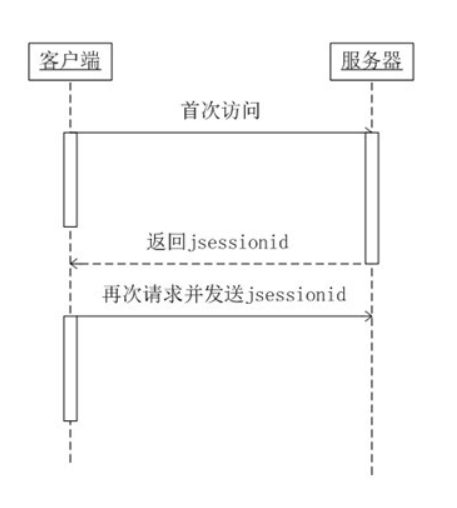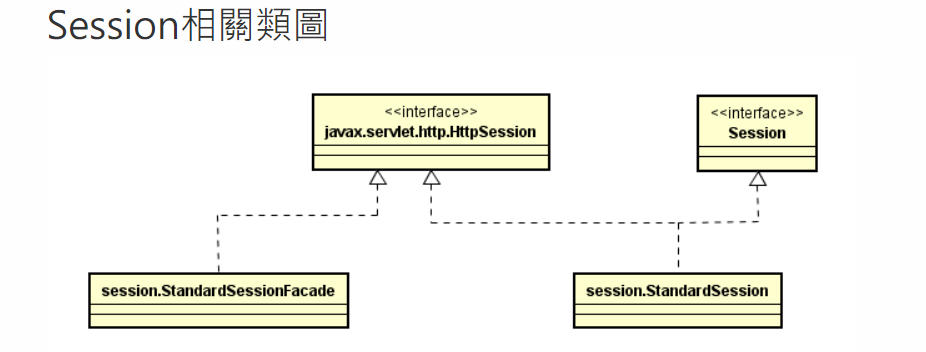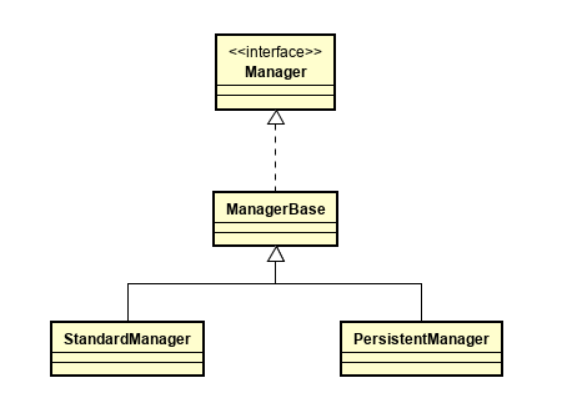JSESSIONID的说明
JSESSIONID作用
因为HTTP协议是无状态的, 所以我们的服务器不知道对方是谁, 所以事实上, 当用户访问服务器的时候, 服务器会为每一个用户开启一个session, 那么浏览器怎么判断这个session到底属于哪个用户呢, 那么Jsessionid就显现出他的优势了, 服务器可以通过它来找到用户session信息, 它可以帮助服务期判断对方的身份(比如说对方是否已经认证过了....), 用代码表示就是:
jsessionid ==request.getSession().getId()

基本流程
-
第一次访问服务器的时候, 会在响应头看到Set-Cookie的信息(只有在首次访问的时候在响应头会出现该信息), 随后浏览器会将浏览器的cookie并保存.但是因为没有设置时间, 所以关闭浏览器后就会消失.
Set-Cookie: JSESSIONID=**********;
-
当再次请求的时候,浏览器会把请求头里面的cookie发送给服务器(每次请求都是这样)
Session对象
Session类图

- HttpSession是我们大家可以直接使用的Session
- StandardSession是标准的HttpSession的实现, 同时它实现了Session接口, 用于Tomcat内部管理
Manager类图

-
Manager是用来储存的Session的类, 它会使用Map来储存Session类
/** * The set of currently active Sessions for this Manager, keyed by * session identifier. */ protected Map<String, Session> sessions = new ConcurrentHashMap<>(); -
其实现类有
StandardManager和PersistentManager类; 两者的区别:- 前者在Tomcat执行的时候, 会把Session储存在内存中, Tomcat关闭的时候,(正常关闭), 会把Session写入到硬盘中, 等到Tomcat重启后将Session写入进来
- 后者直接将Session存入到硬盘中
Manager与Context
在Tomcat中,一個Context就是部署到Tomcat中的一個應用(Webapp)。每一個Context都有一個單獨的Manager物件來管理這個應用的會話資訊。


Session的生命周期
这里我们使用Tomcat作为我们的Web服务器, 那么
-
解析获取
requestedSession和requestSessionID:request.getSeesion()获得Session, 主要调用doGetSession方法//Parameter: create: 在没有获取到Session的情况下, 是否创建一个新的Session protected Session doGetSession(boolean create) { // There cannot be a session if no context has been assigned yet //如果没有上下文容器, 那么没有session Context context = getContext(); if (context == null) { return (null); } // Return the current session if it exists and is valid //如果存在session但是失效, 返回现有的session = null if ((session != null) && !session.isValid()) { session = null; } if (session != null) { return (session); } // Return the requested session if it exists and is valid //如果session可用并且存在 Manager manager = context.getManager(); if (manager == null) { return null; // Sessions are not supported } if (requestedSessionId != null) { try { //通过我们所说的sessionId来寻找session session = manager.findSession(requestedSessionId); } catch (IOException e) { session = null; } if ((session != null) && !session.isValid()) { session = null; } if (session != null) { session.access(); return (session); } } // Create a new session if requested and the response is not committed //否则创建一个Seesion if (!create) { return (null); } if ((response != null) && context.getServletContext().getEffectiveSessionTrackingModes(). contains(SessionTrackingMode.COOKIE) && response.getResponse().isCommitted()) { throw new IllegalStateException (sm.getString("coyoteRequest.sessionCreateCommitted")); } // Re-use session IDs provided by the client in very limited // circumstances. //重用session IDs 被客户端提供的 String sessionId = getRequestedSessionId(); if (requestedSessionSSL) { // If the session ID has been obtained from the SSL handshake then // use it. } else if (("/".equals(context.getSessionCookiePath()) && isRequestedSessionIdFromCookie())) { /* This is the common(ish) use case: using the same session ID with * multiple web applications on the same host. Typically this is * used by Portlet implementations. It only works if sessions are * tracked via cookies. The cookie must have a path of "/" else it * won't be provided for requests to all web applications. * * Any session ID provided by the client should be for a session * that already exists somewhere on the host. Check if the context * is configured for this to be confirmed. */ if (context.getValidateClientProvidedNewSessionId()) { boolean found = false; for (Container container : getHost().findChildren()) { Manager m = ((Context) container).getManager(); if (m != null) { try { if (m.findSession(sessionId) != null) { found = true; break; } } catch (IOException e) { // Ignore. Problems with this manager will be // handled elsewhere. } } } if (!found) { sessionId = null; } } } else { sessionId = null; } //通过manager创建Seesion, 后面会讲到 session = manager.createSession(sessionId); // Creating a new session cookie based on that session if ((session != null) && (getContext() != null) && getContext().getServletContext(). getEffectiveSessionTrackingModes().contains( SessionTrackingMode.COOKIE)) { Cookie cookie = ApplicationSessionCookieConfig.createSessionCookie( context, session.getIdInternal(), isSecure()); //返回一个带有 SessionID的Cookie response.addSessionCookieInternal(cookie); } if (session == null) { return null; } session.access(); return session; }关于
requestedSessionId是如何获取的, Tomcat内部可以支持从 Cookie和URL中获取, 具体查看CoyoteAdapter类中的postPraseRequest:String sessionID; if (request.getServletContext().getEffectiveSessionTrackingModes() .contains(SessionTrackingMode.URL)) { //如果浏览器的Cookie被禁用 //首先尝试在URL中获取, 这里getSessionUriParamName = jsessionid sessionID = request.getPathParameter( SessionConfig.getSessionUriParamName( request.getContext())); if (sessionID != null) { request.setRequestedSessionId(sessionID); request.setRequestedSessionURL(true); } } //在sessionID中获取 parseSessionCookiesId(req, request);具体的
parseSessionCookiesId(req, request)方法://SessionCookieName = JSESSIONID String sessionCookieName = SessionConfig.getSessionCookieName(context); //遍历Cookie, 取出属性名为 JSESSIONID 的字段, for (int i = 0; i < count; i++) { ServerCookie scookie = serverCookies.getCookie(i); if (scookie.getName().equals(sessionCookieName)) { // Override anything requested in the URL if (!request.isRequestedSessionIdFromCookie()) { // Accept only the first session id cookie convertMB(scookie.getValue()); //将读出来的 JSESSIONID 设置在 request上.. request.setRequestedSessionId (scookie.getValue().toString()); request.setRequestedSessionCookie(true); request.setRequestedSessionURL(false); if (log.isDebugEnabled()) { log.debug(" Requested cookie session id is " + request.getRequestedSessionId()); } } else { if (!request.isRequestedSessionIdValid()) { // Replace the session id until one is valid convertMB(scookie.getValue()); request.setRequestedSessionId (scookie.getValue().toString()); } } } } -
通过findSession()查询Session
获取到
SessionId后, 回去寻找session, 不同的管理器获取方式不一样, 默认的是StandardManager:protected Map<String, Session> sessions = new ConcurrentHashMap<String, Session>(); public Session findSession(String id) throws IOException { if (id == null) { return null; } return sessions.get(id); } -
通过creatSession()创建Session
public Session createSession(String sessionId) { //拒绝会话 if ((maxActiveSessions >= 0) && (getActiveSessions() >= maxActiveSessions)) { rejectedSessions++; throw new TooManyActiveSessionsException( sm.getString("managerBase.createSession.ise"), maxActiveSessions); } // Recycle or create a Session instance Session session = createEmptySession(); // Initialize the properties of the new session and return it session.setNew(true); session.setValid(true); session.setCreationTime(System.currentTimeMillis()); session.setMaxInactiveInterval(((Context) getContainer()).getSessionTimeout() * 60); String id = sessionId; //如果没有 SessionId 那么会生成一个唯一的 SessionId if (id == null) { id = generateSessionId(); } //这里我们没有把Session放入到ConcurrentHashMap中, 其实已经在下面这条语句执行过了,可看下一段代码分析 session.setId(id); sessionCounter++; SessionTiming timing = new SessionTiming(session.getCreationTime(), 0); synchronized (sessionCreationTiming) { sessionCreationTiming.add(timing); sessionCreationTiming.poll(); } return (session); }//SessionID设置完成, 自动放入到 Manager public void setId(String id, boolean notify) { if ((this.id != null) && (manager != null)) manager.remove(this); this.id = id; if (manager != null) manager.add(this); if (notify) { tellNew(); } } -
**销毁 Session **
Tomcat会定期检测出不活跃的session,然后将其删除,一方面session占用内存,另一方面是安全性的考虑;启动tomcat的同时会启动一个后台线程用来检测过期的session,具体可以查看
ContainerBase的内部类ContainerBackgroundProcessor:protected class ContainerBackgroundProcessor implements Runnable { @Override public void run() { Throwable t = null; String unexpectedDeathMessage = sm.getString( "containerBase.backgroundProcess.unexpectedThreadDeath", Thread.currentThread().getName()); try { while (!threadDone) { try { //backgroundProcessorDelay默认值为10, 也就是10秒检测一次 Thread.sleep(backgroundProcessorDelay * 1000L); } catch (InterruptedException e) { // Ignore } if (!threadDone) { Container parent = (Container) getMappingObject(); ClassLoader cl = Thread.currentThread().getContextClassLoader(); if (parent.getLoader() != null) { cl = parent.getLoader().getClassLoader(); } //调用processChildren方法 processChildren(parent, cl); } } } catch (RuntimeException e) { t = e; throw e; } catch (Error e) { t = e; throw e; } finally { if (!threadDone) { log.error(unexpectedDeathMessage, t); } } } protected void processChildren(Container container, ClassLoader cl) { try { if (container.getLoader() != null) { Thread.currentThread().setContextClassLoader (container.getLoader().getClassLoader()); } //调用backgroundProcess();方法, 看下段代码分析 container.backgroundProcess(); } catch (Throwable t) { ExceptionUtils.handleThrowable(t); log.error("Exception invoking periodic operation: ", t); } finally { Thread.currentThread().setContextClassLoader(cl); } Container[] children = container.findChildren(); for (int i = 0; i < children.length; i++) { if (children[i].getBackgroundProcessorDelay() <= 0) { processChildren(children[i], cl); } } } }//Manager的方法 //接上47行代码 Container类的backgroundProcess() 方法 public void backgroundProcess() { // count = (count + 1) % processExpiresFrequency; if (count == 0) //如果達到檢查頻率則開始檢查 processExpires(); } /** * Invalidate all sessions that have expired. */ public void processExpires() { long timeNow = System.currentTimeMillis(); Session sessions[] = findSessions();//獲取所有session物件 int expireHere = 0 ;//过期session的数量,不要被這個變數名騙了 if(log.isDebugEnabled()) log.debug("Start expire sessions " + getName() + " at " + timeNow + " sessioncount " + sessions.length); //逐个检测Session查看是否过期 for (int i = 0; i < sessions.length; i++) { //如何检测session是否过期呢? if (sessions[i]!=null && !sessions[i].isValid()) { expireHere++; } } long timeEnd = System.currentTimeMillis(); if(log.isDebugEnabled()) log.debug("End expire sessions " + getName() + " processingTime " + (timeEnd - timeNow) + " expired sessions: " + expireHere); processingTime += ( timeEnd - timeNow ); }/** * Return the <code>isValid</code> flag for this session. */ @Override //判断Session是否过期 public boolean isValid() { if (!this.isValid) { return false; } if (this.expiring) { return true; } if (ACTIVITY_CHECK && accessCount.get() > 0) { return true; } //關鍵所在 //如果有設定最大空閒時間 //就獲取此Session的空閒時間進行判斷 //如果已超時,則執行expire操作 if (maxInactiveInterval > 0) { int timeIdle = (int) (getIdleTimeInternal() / 1000L); if (timeIdle >= maxInactiveInterval) { expire(true); } } return this.isValid; }
Spring Session
Spring Session官方解释
Spring Session provides an API and implementations for managing a user’s session information. It also provides transparent integration with:
- HttpSession
- allows replacing the HttpSession in an application container (i.e. Tomcat) neutral way. Additional features include:
Clustered Sessions() - Spring Session makes it trivial to support clustered sessions without being tied to an application container specific solution.
Multiple Browser Sessions - Spring Session supports managing multiple users’ sessions in a single browser instance (i.e. multiple authenticated accounts similar to Google).
RESTful APIs - Spring Session allows providing session ids in headers to work with RESTful APIs
WebSocket - provides the ability to keep the
HttpSessionalive when receiving WebSocket messages
其具体的特性非常之多,具体的内容可以从文档中了解到,笔者做一点自己的总结,Spring Session的特性包括但不限于以下:
- 使用GemFire来构建C/S架构的HttpSession(不关注)
- 使用第三方仓储来实现集群session管理,也就是常说的分布式session容器,替换应用容器(如tomcat的session容器)。仓储的实现,Spring Session提供了三个实现(Redis,mongodb,jdbc),其中Redis使我们最常用的。程序的实现,使用AOP技术,几乎可以做到透明化地替换。(核心)
- 可以非常方便的扩展Cookie和自定义Session相关的Listener,Filter。
- 可以很方便的与Spring Security集成,增加诸如findSessionsByUserName,rememberMe,限制同一个账号可以同时在线的Session数(如设置成1,即可达到把前一次登录顶掉的效果)等等



